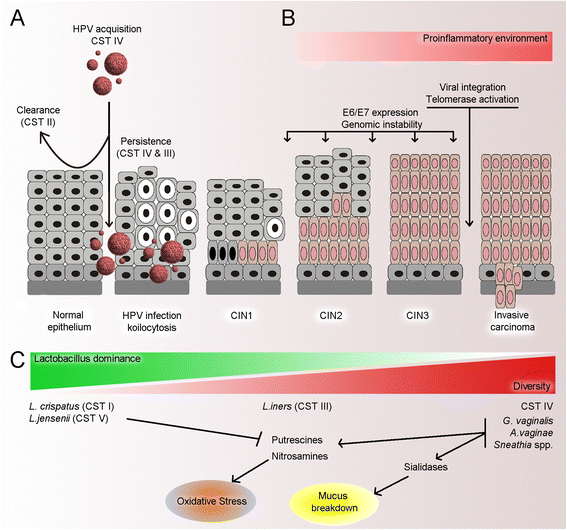The vaginal microbiota, human papillomavirus infection and cervical intraepithelial neoplasia: what do we know and where are we going next?
- PMID: 27802830
- PMCID: PMC5088670
- DOI: 10.1186/s40168-016-0203-0
The vaginal microbiota, human papillomavirus infection and cervical intraepithelial neoplasia: what do we know and where are we going next?
Abstract
The vaginal microbiota plays a significant role in health and disease of the female reproductive tract. Next-generation sequencing techniques based upon the analysis of bacterial 16S rRNA genes permit in-depth study of vaginal microbial community structure to a level of detail not possible with standard culture-based microbiological techniques. The human papillomavirus (HPV) causes both cervical intraepithelial neoplasia (CIN) and cervical cancer. Although the virus is highly prevalent, only a small number of women have a persistent HPV infection and subsequently develop clinically significant disease. There is emerging evidence which leads us to conclude that increased diversity of vaginal microbiota combined with reduced relative abundance of Lactobacillus spp. is involved in HPV acquisition and persistence and the development of cervical precancer and cancer. In this review, we summarise the current literature and discuss potential mechanisms for the involvement of vaginal microbiota in the evolution of CIN and cervical cancer. The concept of manipulation of vaginal bacterial communities using pre- and probiotics is also discussed as an exciting prospect for the field of cervical pathology.
Keywords: CIN; Cervical cancer; Cervical intraepithelial neoplasia; HPV; Human papillomavirus; Lactobacillus species; Prebiotics; Probiotics; Vaginal microbiota.
Figures

References
-
- Walboomers JM, Jacobs MV, Manos MM, Bosch FX, Kummer JA, Shah KV, Snijders PJ, Peto J, Meijer CJ, Munoz N. Human papillomavirus is a necessary cause of invasive cervical cancer worldwide. J Pathol. 1999;189(1):12–19. doi: 10.1002/(SICI)1096-9896(199909)189:1<12::AID-PATH431>3.0.CO;2-F. - DOI - PubMed
-
- Plummer M, Schiffman M, Castle PE, Maucort-Boulch D, Wheeler CM. A 2-year prospective study of human papillomavirus persistence among women with a cytological diagnosis of atypical squamous cells of undetermined significance or low-grade squamous intraepithelial lesion. J Infect Dis. 2007;195(11):1582–1589. doi: 10.1086/516784. - DOI - PubMed
-
- Trottier H, Ferreira S, Thomann P, Costa MC, Sobrinho JS, Prado JC, Rohan TE, Villa LL, Franco EL. Human papillomavirus infection and reinfection in adult women: the role of sexual activity and natural immunity. Cancer Res. 2010;70(21):8569–8577. doi: 10.1158/0008-5472.CAN-10-0621. - DOI - PMC - PubMed
Publication types
MeSH terms
Substances
Grants and funding
LinkOut - more resources
Full Text Sources
Other Literature Sources
Medical
Miscellaneous

